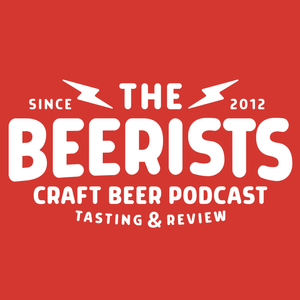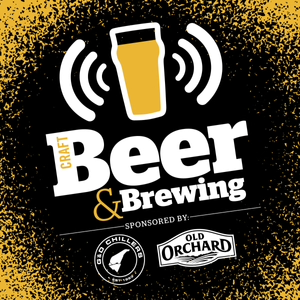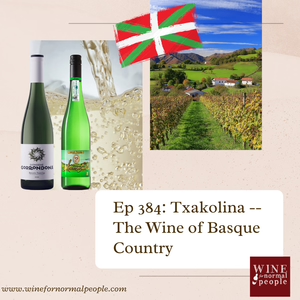
Ep 384: Txakolina --The Wine of Basque Country
07/28/21 • 38 min
2 Listeners
The Basque Country in northeastern Spain lies on the Bay of Biscay and abuts the Pyrenees Mountains, a mere 18 mi/30 km from the French border. Until about a decade ago, this area was relatively unknown as a wine region. But with the rise of Basque cuisine, an increased interest from wine buyers in native varietals, and a desire for lower alcohol, thirst-quenching wines, Txakolina (chock-o-LEEN-ah), a white, high acid, spritzy wine started to get attention. The phenom started in places all over the United States (which boasts a Basque population of more than 50,000 people), then the UK and Japan, now small quantities of wine find their way to many other countries around the world.
Map of Basque Country: Vineyards.com
In this show, we discuss this historic region, with its own language, culture, and wine traditions. We talk about how the modern wine industry was renewed, and what you can expect from these delicious, refreshing (mainly white) wines. If you haven’t had these wines or heard of them, this should will give you a good foundation to learn about them and appreciate all that it took for them to make it to your table!
Here the show notes:
- We give an overview of the Basque region (Euskadi), and the language of Euskera, one of the oldest spoken languages with no link to any other known language
- We discuss the quirky naming convention of the wine of this area, the original name of called txakolin and the meaning of txakolina "the txakolin" – a term was used from middle of the 18th century onwards and how Txakoli was a misspelling used after 1985. (Source: Wikipedia, originally from the Academy of Basque Language)
- The wine is called chacolí in Spanish
- We spend time on the history of Basque country, with a focus on the independent spirit of the Basque people. We discuss the political discord in the region, especially the difficulties with the Basque Separatist Movement. We tie in wine—discussing the importance of the rise of Michelin-starred chefs in the Basque region, the interest of importers like Jorge Ordoñez who imported cases of Txomin Etxaniz to the US in the early 1990s, and how sommeliers and others had growing interest in native grapes
Photo: Guggenheim Museum, Bilbao in Basque Country
- Location: We review where Basque Country is...
- Northern Basque Country: The French part in the Pyrénées-Atlantiques department of France
- Southern Basque Country/El País Vasco of Spain, Basque Autonomous Community: including Álava, Biscay, and Gipuzkoa
- Other areas that make Chacolí (I’m spelling it this way because they are Spanish areas) are Cantabria and Burgos
- Land and climate: We mention features like the Cantabrian Mountains, vineyards near the coast surrounding Bilbao, and vineyards toward the Ebro Valley and Rioja. Vineyards are terraced and on hillsides, some quite steep. We talk about the wet Atlantic climate of the reigon and its effect on the grapes.
Photo: Bodega Doniene Gorrondona
- Grapes: The main grapes are Hondarrabi Zuri (Courbu blanc and here is the link to the blog we mention), Hondarrabi Zuri Zerratia, Hondarrabi Beltza (a red grape for reds and rosés), Also allowed: Bordeleza Zuria/ Mune Mahatsa (Folle Blanche), Izkiriota Ttipia (Petit Manseng), Izkiriota (Gros Manseng), Petit Corbu, Txori mahatsa (Sauvignon Blanc), Chardonnay, Riesling
- Here’s the article I mention in the show about rosé being a creation for the American market...
- Vineyard and winemaking. We discuss the parras – the high pergolas that help keep the airflow through the canopy. We talk about the mainly modern winemaking facilities and methods, but how some of the producers are working with longer lees aging, aging in wood and concrete, and blending. We explore the technique of making the wine under a blanket of nitrogen to ensure spritz in your glass and how it is pour from shoulder height to enhance the fizz in the glass.
Txakolina Vineyard Photo: Josu Goñi Etxabe, Public domain, via Wikimedia Commons
Finally, we discuss the Denominaciones de Origen:
Getariako Txakolina or Txakoli de Getaria, (Chacolí de Guetaria -Spanish), is the most important, oldest, and most prolific DO, yet the smallest geographically. The wines are softer and riper, with less bitterness and great acidity. They nearly always have spritz.
Bizkaiko Txakolina or Txakoli de Bizkaia - (Spanish is Chacolí de Vizca...
The Basque Country in northeastern Spain lies on the Bay of Biscay and abuts the Pyrenees Mountains, a mere 18 mi/30 km from the French border. Until about a decade ago, this area was relatively unknown as a wine region. But with the rise of Basque cuisine, an increased interest from wine buyers in native varietals, and a desire for lower alcohol, thirst-quenching wines, Txakolina (chock-o-LEEN-ah), a white, high acid, spritzy wine started to get attention. The phenom started in places all over the United States (which boasts a Basque population of more than 50,000 people), then the UK and Japan, now small quantities of wine find their way to many other countries around the world.
Map of Basque Country: Vineyards.com
In this show, we discuss this historic region, with its own language, culture, and wine traditions. We talk about how the modern wine industry was renewed, and what you can expect from these delicious, refreshing (mainly white) wines. If you haven’t had these wines or heard of them, this should will give you a good foundation to learn about them and appreciate all that it took for them to make it to your table!
Here the show notes:
- We give an overview of the Basque region (Euskadi), and the language of Euskera, one of the oldest spoken languages with no link to any other known language
- We discuss the quirky naming convention of the wine of this area, the original name of called txakolin and the meaning of txakolina "the txakolin" – a term was used from middle of the 18th century onwards and how Txakoli was a misspelling used after 1985. (Source: Wikipedia, originally from the Academy of Basque Language)
- The wine is called chacolí in Spanish
- We spend time on the history of Basque country, with a focus on the independent spirit of the Basque people. We discuss the political discord in the region, especially the difficulties with the Basque Separatist Movement. We tie in wine—discussing the importance of the rise of Michelin-starred chefs in the Basque region, the interest of importers like Jorge Ordoñez who imported cases of Txomin Etxaniz to the US in the early 1990s, and how sommeliers and others had growing interest in native grapes
Photo: Guggenheim Museum, Bilbao in Basque Country
- Location: We review where Basque Country is...
- Northern Basque Country: The French part in the Pyrénées-Atlantiques department of France
- Southern Basque Country/El País Vasco of Spain, Basque Autonomous Community: including Álava, Biscay, and Gipuzkoa
- Other areas that make Chacolí (I’m spelling it this way because they are Spanish areas) are Cantabria and Burgos
- Land and climate: We mention features like the Cantabrian Mountains, vineyards near the coast surrounding Bilbao, and vineyards toward the Ebro Valley and Rioja. Vineyards are terraced and on hillsides, some quite steep. We talk about the wet Atlantic climate of the reigon and its effect on the grapes.
Photo: Bodega Doniene Gorrondona
- Grapes: The main grapes are Hondarrabi Zuri (Courbu blanc and here is the link to the blog we mention), Hondarrabi Zuri Zerratia, Hondarrabi Beltza (a red grape for reds and rosés), Also allowed: Bordeleza Zuria/ Mune Mahatsa (Folle Blanche), Izkiriota Ttipia (Petit Manseng), Izkiriota (Gros Manseng), Petit Corbu, Txori mahatsa (Sauvignon Blanc), Chardonnay, Riesling
- Here’s the article I mention in the show about rosé being a creation for the American market...
- Vineyard and winemaking. We discuss the parras – the high pergolas that help keep the airflow through the canopy. We talk about the mainly modern winemaking facilities and methods, but how some of the producers are working with longer lees aging, aging in wood and concrete, and blending. We explore the technique of making the wine under a blanket of nitrogen to ensure spritz in your glass and how it is pour from shoulder height to enhance the fizz in the glass.
Txakolina Vineyard Photo: Josu Goñi Etxabe, Public domain, via Wikimedia Commons
Finally, we discuss the Denominaciones de Origen:
Getariako Txakolina or Txakoli de Getaria, (Chacolí de Guetaria -Spanish), is the most important, oldest, and most prolific DO, yet the smallest geographically. The wines are softer and riper, with less bitterness and great acidity. They nearly always have spritz.
Bizkaiko Txakolina or Txakoli de Bizkaia - (Spanish is Chacolí de Vizca...
Previous Episode
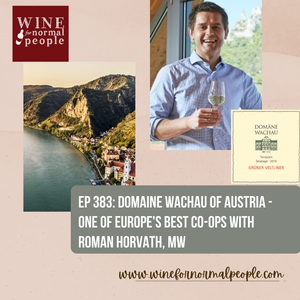
Ep 383: Domaine Wachau of Austria - One of Europe's Best Co-Ops with Roman Horvath, MW
In this show I speak with Roman Horvath, a Master of Wine, is the Winery Director of Domaine Wachau, which is among the leading wine producers in Austria. The Domaine is actually a cooperative, meaning it is run by and owned by individual growers, with Roman bringing them all together under his leadership. But whereas most co-ops in Europe produce seas of mediocre to plain BAD wines, Domaine Wachau has been cited as one of the best co-ops in the world and is known for making wines of origin and pure flavor.
Photo: Domaine Wachau
The Domaine has a full range of Grüner Veltliner and Riesling that reflect their unique terroir – from small vineyard plots on steep terraces along the Danube to regional wines. Roman coordinates the vintner families, who work to capture the terroir of the historic wine region of Wachau. These wines are splendid and show how the co-op system can work well when under the right management.
Here are the show notes:
- Roman tells us about his path through the MW and to becoming the managing director of Domaine Wachau. He gives us some great insight into the MW program (spoiler – it’s probably not what you think!)
Photo of Roman Horvath, MW: Domaine Wachau
- We discuss the structure of Domaine Wachau and what makes it such a successful cooperative (along with Produttori del Barbaresco in Piedmont and La Chablisienne in Chablis). We talk about the success of this co-op versus the thousands of others in Europe and the formula for great wine.
- We discuss Wachau, the small (3321 acres/1,344 hectares), narrow valley carved out by the Danube through marble and mineral rich, amphibolite (metamorphic rock), and quartz-based gneiss (said "nice) rock. We talk about the effect of the Danube, climate patterns, and the individual 155 Rieden (single vineyards like the famed Kellerberg, Achleiten and Singerriedel), as well as the vital importance of the stone terraces (terrasen) to mountainside viticulture in Wachau.
Photo: Domaine Wachau
- Roman tells us about the style we can expect from the Grüner Veltliner and the Riesling that grow in Wachau, and factors that make a difference in style – from terroir to aging. We talk about why screw cap is fantastic for young wine but why cork is a better bet for aging wines.
- We discuss the two classification systems that Wachau is part of – the national DAC system, which includes a Burgundy-like place-based classification system (Gebeitsweine for Regional Wine, Ortswein for Village wine, Riedenwein for single vineyard wines) and Wachau’s own classification by ripeness under the Vinea Wachau, which includes wines labeled Steinfeder, Federspiel, and Smargd (in order of lightest to heaviest)
Map: Wine for Normal People book
- We wrap with a conversation about climate change and the future for Wachau. Roman mentions some excellent other Austrian regions: Burgenland for reds, and Kremstal, Kamptal, Wagram, Traisental for whites.
This conversation gave me a new appreciation for Wachau and for successful co-ops. Domaine Wachau is great and I know I will appreciate Grüner Veltliner and Riesling from the majestic area more than I ever have before!
_____________________________________________________________
Thanks to our sponsors this week:
Thanks to YOU! The podcast supporters on Patreon, who are helping us to make the podcast possible and who we give goodies in return for their help! Check it out today: https://www.patreon.com/winefornormalpeople
And to sign up for classes, please go to www.winefornormalpeo...
Next Episode
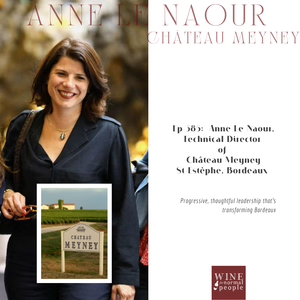
Friends of the Pod Series -- Ep 385: Anne Le Naour of Chateau Meyney - Redefining Saint-Estèphe of Bordeaux
Anne Le Naour is the technical and managing director for Château Meyney of St-Estèphe in the Médoc of Bordeaux. She also manages the other properties of CA Grands Crus. The company is owned by the top bank that supports wine in France, Crédit Agricole Group (sometimes referred to as "la banque verte" due to its historical connections with farming). Its current portfolio includes Chateaux Meyney, 5th growth Grand Puy Ducasse in Pauillac, and Santenay in Burgundy.
Le Naour is a trained oenologist with global experience and since she began at Meyney in 2016, she has transformed the Château, restructuring vineyards, improving viticulture, and moving towards organics. She has introduced better winemaking – less extraction, less obvious oak, and more care in handling vine and wine. Her deep knowledge of wine and winemaking, plus her unwavering dedication to quality has meant that the wines of Meyney are attracting more attention than ever.
These are exquisite wines, underpriced for what they are (Meyney is right next to second growth, Montrose, incidentally, even though it was unfairly omitted from the 1855 classification) and Anne joins to tell us about her outstanding career, the underappreciated area of St-Estèphe on the Left Bank, and the beautiful wines of the historic Château Meyney. Here's my quick tasting video for a review.
Here are the notes from our conversation:
- We open with a discussion of Meyney and its heritage first an ecclesiastical property, then as a woman-owned property (that was, at that time, conspicuously left out of the 1855 classification), to the more recent family ownership and then to Credit Agricolé, the current owner.
Photo: Château Meyney
- Anne gives an overview of her outstanding career, where she worked at chateaux and domaine in Champagne (Mumm), Burgundy, Loire, Bordeaux (at Château Beychevelle) --some of the biggest names in French wine. She discusses her time in the Yarra Valley of Australia (Yering Station), and the US working with David Abreu. We discuss how her curiosity and a bit of innocence about how hard it would be to break into the industry helped her excel, and how going to Australia gave her an education of a lifetime.
- We discuss what it means to be of Generation X and in a management role in wine, and how our generation differs from others.
We move on to St-Estèphe, and why it is not as esteemed as it should be...
- Anne posits that St. Estèphe’s distance from Bordeaux city – it takes 1.5 hours to travel St-Estèphe vs. 40 mintues to Margaux, may make it less desirable.
- We discuss the terroir – the traditional ability for wines to get riper in Margaux and St-Julien (those wines were known for elegance) vs St-Estèphe (called rustic). With better decisions in the vineyard and with winemaking the wines of St-Estèphe are often full and elegant – the best of all world due to the presence of gravel on the top soils to help ripening and clay beneath to keep soils wet during periods of drought.
Map: Bordeaux.com, Vins de Bordeaux
The we discuss the specifics of what Anne has done to improve the vineyards and wines of Meyney. This is a great education session on what actually matters in the vineyard and why. We discuss some specific improvements that have been made at Meyney to boost wine quality:
- Switching Merlot and Cabernet Sauvignon sites to improve quality of the wine dramatically
- Using better grape material – quality over quantity is now the priority
- Improving canopy management and increasing vine density
- Watching extractions and over-use of oak
- Creating a unique style for the second wine, Prieur de Meyney
- Organic and sustainable practices to improve soil health
We wrap up with a discussion of how we need to keep terroir in mind, but be flexible about our ideas of...
If you like this episode you’ll love
Episode Comments
Featured in these lists
Generate a badge
Get a badge for your website that links back to this episode
<a href="https://goodpods.com/podcasts/wine-for-normal-people-39399/ep-384-txakolina-the-wine-of-basque-country-15672333"> <img src="https://storage.googleapis.com/goodpods-images-bucket/badges/generic-badge-1.svg" alt="listen to ep 384: txakolina --the wine of basque country on goodpods" style="width: 225px" /> </a>
Copy
